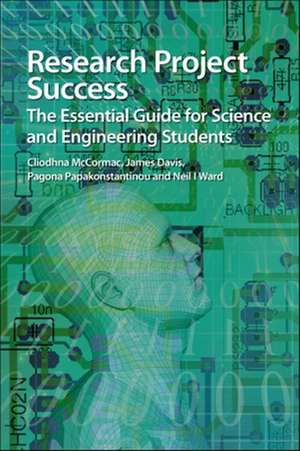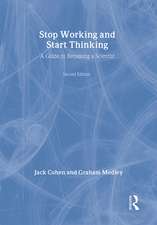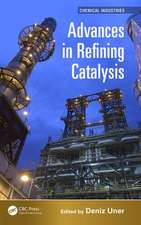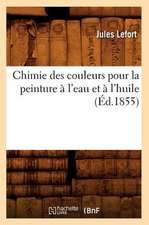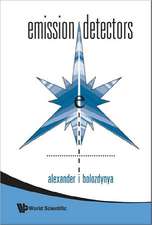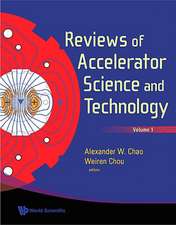Research Project Success
Autor Cliodhna McCormac, James Davis, Pagona Papakonstantinou, Neil I. Warden Limba Engleză Paperback – 13 sep 2012
The undergraduate research project is almost universally treated as the culmination of all previous lecture, lab and tutorial work. The project allows for the development of individuality and confers ownership of a challenge possessing an originality that goes far beyond the communal legacy presented by age old lab scenarios. Central to this is the magical transition of the student from a consumer of knowledge to a producer, yet the journey is often both daunting and perplexing when considering where to start and how to reach the destination using the resources provided and in the allotted time. There are numerous books within the social sciences which provide students with guidance on how to conduct a "successful" project but few can be found in relation to the physical sciences. This can be ascribed to the fact that the former has a very similar structure and procedural methodology whereas the latter can possess a near fractal differentiation into a myriad of sub disciplines and specialisms thereby preventing the provision of a single, expansive catchall text. This book adapts some of the components and ethos of the Projects in Controlled Environments (PRinCE2) project management approach to physical science projects. This is the industry and government standard and was introduced to address the common causes of project failure ie. not delivering projects on time, within budget, within scope or to the right quality. It has rapidly emerged as an international standard and most graduates will doubtless encounter it upon moving outside academia and into the wider world. It is a concise, multilevel resource that provides guidance on the core components common to almost every project within the physical, engineering and life sciences (problem assessment and contextualisation, literature review practices, sources and citation, data presentation, reporting styles, data analysis and error etc). It standardises the delivery of the material but, more importantly, links the components together by outlining a coherent procedural road map that can highlight to the student "what to do", "when to do it" and "how to solve it" procedures. The content of the book is presented through case studies so as to enhance the relevance of the processes, presents examples of good practice and, in keeping with the toolbox approach, can be readily adapted and applied by the students. The book is an accessible reference guide for students, written in a light style, suitable for dipping in and out of as required and the "how to/when to/what if" examples are presented in an often humorous light. It includes flow charts to emphasize the project planning, dissertation components etc and charts to highlight presentation of data, analysis, interpretation and error.
Preț: 179.92 lei
Nou
Puncte Express: 270
Preț estimativ în valută:
34.43€ • 35.94$ • 28.49£
34.43€ • 35.94$ • 28.49£
Carte disponibilă
Livrare economică 14-28 martie
Preluare comenzi: 021 569.72.76
Specificații
ISBN-13: 9781849733823
ISBN-10: 1849733821
Pagini: 140
Ilustrații: black & white illustrations, black & white tables, figures
Dimensiuni: 154 x 229 x 16 mm
Greutate: 0.25 kg
Editura: Royal Society Of Chemistry
ISBN-10: 1849733821
Pagini: 140
Ilustrații: black & white illustrations, black & white tables, figures
Dimensiuni: 154 x 229 x 16 mm
Greutate: 0.25 kg
Editura: Royal Society Of Chemistry
Cuprins
Preparing the Groundwork; Background Material; Conducting the Review; Health and Safety - Risk Assessments and COSHH; Doing the Work; Writing the Dissertation; Preparing a Poster
Notă biografică
Cliodhna McCormac is presently involved in the project management of several multi-centre projects (EPSRC, Royal Society, Royal Academy of Engineering) and is the Collaborating Investigator on an EPSRC Partnership for Public Engagement award to develop new teaching resources to enhance the profile of Engineering within primary and secondary schools in the UK. She is a qualified PRinCE2 practitioner and is responsible for the delivery of the methodology throughout a variety of single and multi-centre projects being conducted with the University of Ulster and has over 16 years experience of teaching across various student levels. James Davis is Professor of Biomedical Sensors within the Nanotechnology and Integrated Bioengineering Centre (NIBEC) at the University of Ulster. James has participated in, and is the principal investigator/coordinator of a number of multi-centre - multi-discipline research collaborations with funding from the EPSRC, Wellcome Trust, Juvenile Diabetes Research Foundation, Royal Society and Heart Research UK. Pagona Papakonstantinou moved to the University of Ulster in 1998 embarking on a new research programme addressing the synthesis, functionalization and comprehensive characterisation of diamond like carbon. Currently her group specializes in the fabrication of low dimensional carbon based nanomaterials and the demonstration of these materials in biological sensing and energy areas. Neil Ward is Professor of Analytical Chemistry at the University of Surrey. He is Chair of the Professional Training and Careers Committee (PTCC) which regulates the operation and quality enhancement of the work-integrated learning or professional training placement programmes across all departments of the University of Surrey. Neil holds a number of teaching development grant awards and has introduced a variety of undergraduate teaching initiatives aimed at enhancing industry based projects and professional training.
Textul de pe ultima copertă
Guidebook, project atlas, reference book and instruction manual. If you are a student within the physical, engineering and life sciences about to embark on a project – whether at undergraduate or postgraduate level – then this is the book for you. The book introduces you to the core components common to almost every project within the physical, engineering and life sciences (problem assessment and contextualisation, literature review practices, sources and citation, data presentation, reporting styles, data analysis and error etc.) and offers guidance as to how best to steer a course to project success. It adapts some of the components and ethos of the Projects in Controlled Environments (PRinCE2) project management approach to physical science projects. This is the industry and government standard and was introduced to address the common causes of project failure i.e. not delivering projects on time, within budget, within scope or to the right quality. It has rapidly emerged as an international standard and most graduates will doubtless encounter it upon moving outside academia and into the wider world. Not only does it provide all the project fundamentals a student may need – no matter the course – but, it also, links these components together by means of a simple and readily accessible project road map to highlight to the student “what to do”, “when to do it” and “how to solve it” procedures. Case studies are incorporated throughout to bring home the relevance of the processes outlined and present examples of good practice and in keeping with the toolbox approach; these case studies can be readily adapted and applied by students. Included are flow charts to emphasize the project planning, dissertation components etc. and charts to highlight presentation of data, analysis, interpretation and error. Suitable for dipping in and out of as required, with the “how to/when to/what if” examples presented in an often humorous light and written in an easy style, this book offers a concise, no-nonsense project reference guide for students.
Descriere
A concise, multilevel book providing guidance on the core components common to most projects within the physical, engineering, and life sciences.
